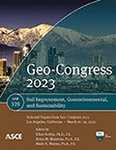Effect of Treatment Strategies for MICP-Based Soil Improvement Using Urease-Producing Bacteria
Publication: Geo-Congress 2023
ABSTRACT
Microbial-induced calcite precipitation (MICP) is one of the bioengineering approaches explored in the last decades for engineering applications such as slope stabilization, liquefaction, and soil erosion. The bio-cementation and bio-clogging properties in MICP-treated soil depend on the treatment sequence (TS) strategies and composition of MICP solutions, which can affect the uniformity of calcium carbonate precipitation and soil properties. The current study compared the seven treatment sequences (TS) for the MICP process with the surface percolation method for soil strength improvement. Results revealed that soil samples followed TS 1 through TS 7 demonstrated bio-cementation properties and showed suitable pH after the treatment. However, the degree of bio-cementation is significantly affected by the treatment sequence. The samples followed by TS 4 and TS 6 have shown adequate bio-cementation and higher unconfined compressive strength compared to other treatment sequences. The microscopic investigations on the specimens extracted from soil samples of TS 1 through TS 7 revealed that TS 4 and TS 6 have more uniform and effective CaCO3 precipitation.
Get full access to this article
View all available purchase options and get full access to this chapter.
REFERENCES
Cheng, L., Cord-Ruwisch, R., and Shahin, M. A. (2013). Cementation of sand soil by microbially induced calcite precipitation at various degrees of saturation. Canadian Geotechnical Journal, 50(1), 81–90.
Cussac, V., Ferrero, R. L., and Labigne, A. (1992). Expression of Helicobacter pylori urease genes in Escherichia coli grown under nitrogen-limiting conditions. Journal of bacteriology, 174(8), 2466–2473.
DeJong, J. T., Mortensen, B. M., Martinez, B. C., and Nelson, D. C. (2010). Bio-mediated soil improvement. Ecological Engineering, 36(2), 197–210.
Dhami, N. K., Reddy, M. S., and Mukherjee, A. (2014). Application of calcifying bacteria for remediation of stones and cultural heritages. Frontiers in microbiology, 5, 304.
Ehrlich, H. L. (1998). Geomicrobiology: its significance for geology. Earth-Science Reviews, 45(1-2), 45–60.
Feng, K., and Montoya, B. M. (2016). Influence of confinement and cementation level on the behavior of microbial-induced calcite precipitated sands under monotonic drained loading. Journal of Geotechnical and Geoenvironmental Engineering, 142(1), 04015057.
Ghasemi, P., Zamani, A., and Montoya, B. (2019, March). The effect of chemical concentration on the strength and erodibility of MICP treated sands. In Geo-Congress 2019: Soil Improvement (pp. 241–249). Reston, VA: American Society of Civil Engineers.
Gowthaman, S., Iki, T., Nakashima, K., Ebina, K., and Kawasaki, S. (2019). Feasibility study for slope soil stabilization by microbial induced carbonate precipitation (MICP) using indigenous bacteria isolated from cold subarctic region. SN applied sciences, 1(11), 1–16.
Harkes, M. P., Van Paassen, L. A., Booster, J. L., Whiffin, V. S., and van Loosdrecht, M. C. (2010). Fixation and distribution of bacterial activity in sand to induce carbonate precipitation for ground reinforcement. Ecological Engineering, 36(2), 112–117.
Kim, G., Kim, J., and Youn, H. (2018). Effect of temperature, pH, and reaction duration on microbially induced calcite precipitation. Applied Sciences, 8(8), 1277.
Liang, S., Xiao, X., Li, Z., and Feng, D. (2021). Effect of Nutrient Solution Composition on Bio-Cemented Sand. Crystals, 11(12), 1572.
Liu, B., Tang, C. S., Pan, X. H., Zhu, C., Cheng, Y. J., Xu, J. J., and Shi, B. (2021). Potential Drought Mitigation Through Microbial Induced Calcite Precipitation‐MICP. Water Resources Research, 57(9), e2020WR029434.
Ma, G., He, X., Jiang, X., Liu, H., Chu, J., and Xiao, Y. (2021). Strength and permeability of bentonite-assisted biocemented coarse sand. Canadian Geotechnical Journal, 58(7), 969–981.
Mahawish, A., Bouazza, A., and Gates, W. P. (2019). Unconfined compressive strength and visualization of the microstructure of coarse sand subjected to different biocementation levels. Journal of Geotechnical and Geoenvironmental Engineering, 145(8), 04019033.
Maleki, M., Ebrahimi, S., Asadzadeh, F., and Emami Tabrizi, M. (2016). Performance of microbial-induced carbonate precipitation on wind erosion control of sandy soil. International journal of environmental science and technology, 13(3), 937–944.
Monteiro, P. J., Miller, S. A., and Horvath, A. (2017). Towards sustainable concrete. Nature materials, 16(7), 698–699.
Montoya, B. M., DeJong, J. T., and Boulanger, R. W. (2014). Dynamic response of liquefiable sand improved by microbial-induced calcite precipitation. In Bio-and Chemo-Mechanical Processes in Geotechnical Engineering: Géotechnique Symposium in Print 2013 (pp. 125–135). ICE Publishing.
Omoregie, A. I., Khoshdelnezamiha, G., Senian, N., Ong, D. E. L., and Nissom, P. M. (2017). Experimental optimisation of various cultural conditions on urease activity for isolated Sporosarcina pasteurii strains and evaluation of their biocement potentials. Ecological Engineering, 109, 65–75.
Sharma, M., Satyam, N., and Reddy, K. R. (2021). Rock-like behavior of biocemented sand treated under non-sterile environment and various treatment conditions. Journal of Rock Mechanics and Geotechnical Engineering, 13(3), 705–716.
Tang, C. S., Yin, L. Y., Jiang, N. J., Zhu, C., Zeng, H., Li, H., and Shi, B. (2020). Factors affecting the performance of microbial-induced carbonate precipitation (MICP) treated soil: a review. Environmental Earth Sciences, 79(5), 1–23.
Wei, H., Wen, K., Liu, S., Li, L., and Amini, F. (2021). Development of light-weight hollow constructional materials through microbial-induced calcium carbonate precipitation. Arabian Journal of Geosciences, 14(20), 1–11.
Whiffin, V. S., Van Paassen, L. A., and Harkes, M. P. (2007). Microbial carbonate precipitation as a soil improvement technique. Geomicrobiology Journal, 24(5), 417–423.
Xiao, Y., Xiao, W., Ma, G., He, X., Wu, H., and Shi, J. (2022). Mechanical Performance of Biotreated Sandy Road Bases. Journal of Performance of Constructed Facilities, 36(1), 04021111.
Information & Authors
Information
Published In
History
Published online: Mar 23, 2023
Authors
Metrics & Citations
Metrics
Citations
Download citation
If you have the appropriate software installed, you can download article citation data to the citation manager of your choice. Simply select your manager software from the list below and click Download.
